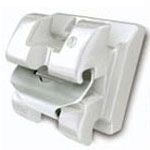1. type – Aesthetic, sapphire or ceramic braces
 |
The tiny elements of these braces, the so-called brackets, are hard to notice on the surface of the teeth. Light and trasparent, but as efficient as the traditional metallic brace system.
Main advantages of this system:
|
2. type – Aesthetic, self-ligating braces (In-Ovation C )
 |
Using gentle and adjustable amount of force and little friction is a new brach of orthodontics developing very dinamicly. Due to the favorable properties of this system it became possible to move teeth more gently, that is more tolerable for the teeth and for the surrounding bone. Also, if needed, a strong hold can be created. This possibility, beside being more comfortable, may open new horisons in the field of orthodontics by avoiding undesired extractions or by other alternations of the traditional orthodontic treatment. Made of ceramic with little silvery wings. |
 |
Main advantages of this system:
|
3. type – Metallic, self-ligating braces (In-Ovation R )
 |
Using gentle and adjustable amount of force and little friction is a new brach of orthodontics developing very dinamicly. Due to the favorable properties of this system it became possible to move teeth more gently, that is more tolerable for the teeth and for the surrounding bone. Also, if needed, a strong hold can be created. This possibility, beside being more comfortable, may open new horisons in the field of orthodontics by avoiding undesired extractions or by other alternations of the traditional orthodontic treatment. Metallic equivalent of In-Ovation C. |
 |
Main advantages of this system:
|
4. type – Classic metallic braces
We call this system ’classic’ because of its traditional metallic material, since long time ago this was the only material from which tiny, precision elements of any kind could be casted. ( The properties of the very early ceramics and other synthetic braces were not nearly as good as that of metal, so they did not count as an alternative like today.) This system also went trough a dynamic development: the ’ancient’ bands are now reduced to ’brackets’, which can be very small and rounded.
 |
Main advantages of this system:
|
5. type – Removable braces
Individually made from wires and plastic by the dental technician on the cast. It can only limitedly be applied in adults, for more simple cases. The more it is in the mouth, the sooner we see the favourable chenges. Recommended daily weartime is 10-12 hours.
 |
Main advantages of this system:
|
6. type – Lingual braces
A system that is fixed on the inside of the teeth, thus fully invisible. In contrast to the regular brace on the outside of the teeth, this is individually made in well known laboratories in Hungary and abroad.
 |
Main advantages of this system:
|
7. type – Invisalign type of braces
 |
Invisible, removable and comfortable orthodontic system. Easy and moderate cases can be treated with this type. It is individually made in the dental laboratory, with the amount of splints depending ont he severeness of the case. Each spint moves the teeth a little, and the next spint further improves the situation. This device needs to be worn 20 to 22 hours a day, that is, almost continuously, with the exception of meals and when brushing teeth.
Main advantages of this system:
|
8. type – Trainer type of orthodontic appliance
 |
The primary task of the trainers is to eliminate dysfunctions and bad habits, such as mouth breathing or inappropriate swallowing patterns. Merely by achieving this, we can take a large step toward optimizing the position of the teeth. These devices are made of soft silicone material, so they are comfortable to wear. Rarely used in adult orthodontics, usually as an adjunct of the fixed braces or as a protective device. |













